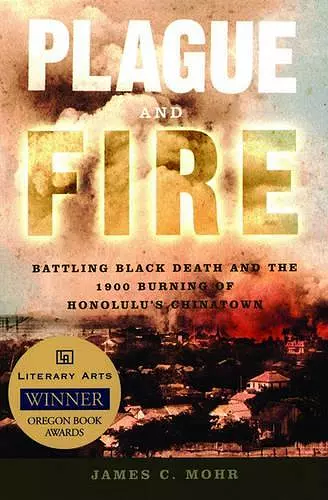Plague and Fire
Battling Black Death and the 1900 Burning of Honolulu's Chinatown
Format:Paperback
Publisher:Oxford University Press Inc
Published:31st Aug '06
Currently unavailable, currently targeted to be due back around 25th January 2025, but could change

A little over a century ago, bubonic plague--the same Black Death that decimated medieval Europe--arrived on the shores of Hawaii just as the islands were about to become a U.S. territory. In this absorbing narrative, James Mohr tells the story of that fearful visitation and its fiery climax--a vast conflagration that engulfed Honolulu's Chinatown. Mohr tells this gripping tale largely through the eyes of the people caught up in the disaster, from members of the white elite to Chinese doctors, Japanese businessmen, and Hawaiian reporters. At the heart of the narrative are three American physicians--the Honolulu Board of Health--who became virtual dictators when the government granted them absolute control over the armed forces and the treasury. The doctors soon quarantined Chinatown, where the plague was killing one or two people a day and clearly spreading. They resisted intense pressure from the white community to burn down all of Chinatown at once and instead ordered a careful, controlled burning of buildings where plague victims had died. But a freak wind whipped one of those small fires into a roaring inferno that destroyed everything in its path, consuming roughly thirty-eight acres of densely packed wooden structures in a single afternoon. Some 5000 people lost their homes and all their possessions and were marched in shock to detention camps, where they were confined under armed guard for weeks. Next to the attack on Pearl Harbor in 1941, the Chinatown fire is the worst civic disaster in Hawaiian history. A dramatic account of people struggling in the face of mounting catastrophe, Plague and Fire is a stimulating and thought-provoking read.
"James Mohr is not just content to tell a compelling story. He connects Honolulu's plague and the fire of 1900 to the great themes of the day: empire, race, power, and fear. I am now convinced that disasters are key historical moments when societies reveal their most fundamental truths. It all comes together here."--Elizabeth Fenn, author of Pox Americana: The Great Smallpox Epidemic of 1775-82
"Extensive research, sturdy prose, impressive analysis."--Kirkus Reviews
"Compelling.... Mohr covers the doctors' best efforts like a detective writer, highlighting the clues they used, and the ones they simply could not have been aware of at the time.... The narrative is rich with cultural, political, and economic detail.... Opening the door onto the human strengths and shortcomings of the key players turns what could have been a flat textbook into a near-page-turner.... More than a century later, Mohr's sharp curiosity has helped convey the significance of this remarkable event to a wide audience."--Boston Globe
"An excellent work of scholarship and a lively read. Professor Mohr has done exhaustive research in primary sources to document his fascinating tale of public health, politics, and racial relations. The book is a significant contribution to the history of medicine and public health and to American history more broadly." --John Parascandola, author of The Development of American Pharmacology: John J. Abel and the Shaping of a Discipline
"Plague and Fire is a riveting account of why, how and with what consequences physician leaders in Hawaii a century ago assumed emergency health powers. Mohr's themes have contemporary resonance, especially his analysis of the effects of scientific uncertainty on policy, competing perceptions of private interests and the common good, and the potential for public health interventions to become vectors for disaster." --Daniel M. Fox, President, Milbank Memorial Fund
- Winner of Winner of the Frances Fuller Victor Award for General Nonfiction, Oregon Book Awards.
ISBN: 9780195311822
Dimensions: 225mm x 154mm x 17mm
Weight: 345g
256 pages